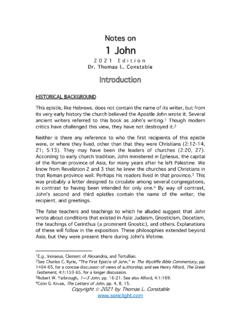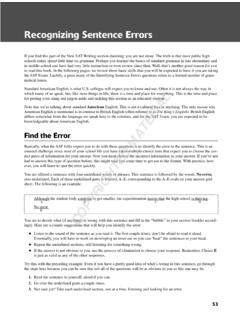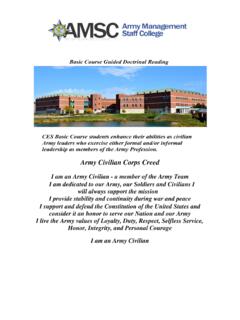Transcription of Teaching Composition: Research on Effective Practices
1 Teaching Composition: Research on Effective Practices Kathleen Cotton INTRODUCTION Educators and their constituents have differing opinions as to what constitutes the "basic skills." Nearly everyone, however, would cite the "three Rs" -- Reading, w(R)iting and 'Rithmetic -- which have traditionally been regarded as the core of the educational program at all levels of instruction. The focus of the present report is the writing part of that core. Given the broad general agreement about the importance of learning to write, it is disturbing to discover that "most researchers and educators agree that, with rare exceptions, students do not and cannot write well" (Amiran and Mann 1982, p. 3). In preparation for a report sponsored by the American Association of School Administrators, Neill (1982) conducted a survey of 425 school districts and found that 90 percent of the respondents considered student writing to be a problem -- either a serious problem (40 percent) or a minor problem (50 percent).
2 Neill also quoted a late 1970s report stating that the reasons given by some corporations for leaving urban environments is that they couldn't find people for clerical jobs who are minimally competent in basic skills, including writing. Unfortunately, writing is an area characterized by considerable divergence between Research and practice. Smith (1982) notes that "much is known about which Practices in Teaching the writing process are Effective , [but] several of these findings are in conflict with widespread Practices in the schools" (p. 3). For example, staff of the ERIC Clearinghouse on Reading and Communication Skills reported in 1984 that "while most authorities of writing agree that children learn to write by writing, [there is] a distressing lack of classroom time devoted to extended periods of writing" (p. 1). Still, writing remains a critical area of the school curriculum and an important part of students' lives after school.
3 In addition to the insistence of many employers that employees possess well-developed communication skills -- including writing skills -- a variety of other purposes are served by writing and developing writing capability. Graves (1978) identified several ways that writing is important in our lives: As a contribution to the development of a person, no matter what that person's background and Writing is a highly complex act that demands the analysis and synthesis of many levels of thinking. Writing develops initiative. In reading, everything is provided. In writing, the learner must supply everything: the right relationship between sounds and letters, the order of the letters and their form on the page, the topic, information, questions, answers, order. Writing develops courage. At no point is the learner more vulnerable than in writing. Writing, more than any other subject, can lead to personal breakthroughs in learning.
4 Writing can contribute to reading from the first day of school. Writing, some say, is active, whereas reading is passive. Writing contributes strongly to reading comprehension as children grow older. The ability to revise writing for greater power and economy is one of the higher forms of reading. (pp. 5-6) Ways to help students achieve these goals are discussed in a later section on composition Research . To set a context for presenting this information, the next section discusses the Research base concerning Effective schooling in general. THE Effective SCHOOLING Research The Effective schooling Research base has grown immensely in the past two decades. During this time, a great many researchers have looked at the factors which distinguish schools and classrooms with high achieving, appropriately behaving students from those in which student achievement, behavior and affect are less positive.
5 While the Effective schooling Research has contributed greatly to our knowledge about Effective instructional, managerial and environmental elements, it is limited in that most of its findings pertain to students in general and instruction in general. It remains important to ask whether these general findings pertain to particular kinds of students ( , a given age/grade level or special needs population) and to specific areas of the curriculum. In 1984, the School Improvement Program (then called the Goal Based Education Program) of the Northwest Regional Educational Laboratory published a synthesis of the Research on Effective schooling Practices . This document presents, in list form, a distillation of the findings presented in nearly 300 Research documents. Organized into sections on classroom, school and district characteristics and Practices , this synthesis offers a wealth of information on approaches for improving student learning and behavior.
6 In the Classroom Characteristics and Practices section of the synthesis, over 50 major assertions are made (and supported) concerning instructional and behavior management techniques at the classroom level. These are organized into 12 clusters having to do with such areas as expectations for student learning, monitoring student progress, and grouping students for instruction. Looking at the Effective schooling Research , as outlined in the 1984 synthesis, and the Research on composition reveals a high degree of congruence. Those familiar with the general Effective schooling Research will find nothing jarring or contradictory in the Research base on Effective Practices in composition instructions. As the findings from the Research on composition are discussed, references will be made to the ways these are corroborated by the Research on Effective schooling. THE Research ON WRITTEN COMPOSITION Thirty-six Research documents were reviewed in preparation for this report.
7 Sixteen were review/synthesis documents, fifteen were reports of experimental studies, two reported results of both a review and a study, one was a program evaluation document, and two reported on the same review effort. Nine of the documents concerned elementary students, another nine reported on Research with secondary students, twelve had to do with the K-12 range, and two looked at the entire K-postsecondary span. The outcome area of concern in 26 of the reports was writing achievement, either in general or as indicated by measures of syntactic maturity, fluency, various writing subskills, degree of change or degree of retention of skills over time. Seven reports presented findings on the affective outcomes of various approaches to instruction. These reported on student attitudes toward writing, self-esteem, motivation, and extent of cooperation and collaboration with others. Four studies looked at the effects of treatment on reading comprehension as well as writing achievement.
8 WRITING AS A PROCESS The major general finding from the Research on Teaching writing is that student achievement is higher when the Teaching approach emphasizes writing as a process rather than writing as a product (Parson 1985; Holdzkom, et al. 1982; Hillocks 1984, 1986; Wesdorp 1983; Amiran and Mann 1982; Keech and Thomas 1979; ERIC Clearinghouse 1984). As Parson (1985) points out, in the traditional product-oriented approach, form and correctness are the major concerns. The teacher provides drill work on specific skills, makes many of the major writing decisions for the students (topic, form, length, etc.) and serves as the sole audience/judge. Learning involves following rules, conforming to formulae, and achieving technical mastery of formal conventions and modes. Students work alone on their writing assignments, and while trying to figure out what they want to say, are reminded of such technical matters as using topic sentences and avoiding writing sentence fragments and run-ons.
9 Insofar as possible, the student in the product-oriented writing class tries to get it right the first time, because the paper turned in will be the only version. The teacher painstakingly marks all the mechanical errors in red ink and writes notes in the margins about the logic and clarity of the essay. Because the student will be doing nothing further with the piece, he/she often pays little attention to the teacher's comments. As Parson notes, under these conditions, there isn't much of a sense of ownership or investment in the writing. Virtually all the various subparts of the traditional approach have been shown to be ineffective in producing capable writers. Parson identifies several reasons for the failure of this approach: It emphasizes form and mechanics before, and often at the expense of, ideas and meaning. It focuses on the product rather than the process. It seriously neglects the earliest stages of the writing process.
10 It offers too many artificial contexts for writing. It isolates mechanical skills from the context of writing. Rather than being an outgrowth of Research and experimentation, the traditional approach is based on sheer historical momentum of outmoded theoretical assumptions (p. 9). From the experience of classroom teachers and from the Research conducted during the past 15 years, there has emerged a process-oriented approach to Teaching writing. recognizing that writing is a complex, recursive, dynamic nonlinear process, experts in the field of composition have developed and tested instructional methods more in keeping with the true nature of the act of writing. Looked at this way, it becomes obvious that the process has a number of distinct stages (Parson 1985; Holdzkom, et al. 1982; Hillocks 1984, 1986; Wesdorp 1983; Applebee 1981). These include: Prewriting. The writer gathers information and plays with ideas during the prewriting stage.













